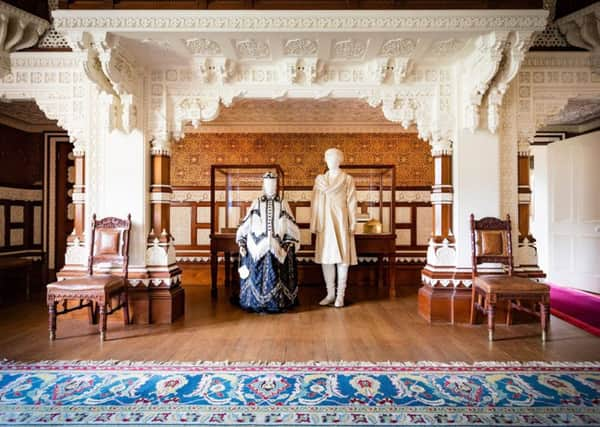Travel review: Stepping back to Victoria's time on the Isle of Wight


As train journeys go, this one goes remarkably quickly. We set off from Havenstreet at 10.06, arrive in Wootton at 10.13, and head more or less straight back. We’re actually a minute late on the outward journey, but no-one on the Isle of Wight Steam Railway is counting.
This all-huffing, all-puffing heritage line – part of which my wife and I are sampling – takes 250,000 passengers a year (mostly tourists) on what it calls “ten-mile trips back in time”. It’s a neat slogan and it encapsulates the Isle of Wight itself; a holiday there is a reassuring trip back to the 1970s, maybe the 1960s, maybe even the 1890s.
Advertisement
Hide AdAdvertisement
Hide AdThat was when the ageing Queen Victoria, who loved the island and built herself the grandest of holiday homes there at Osborne House, took a shine to her young Indian servant Abdul Karim. Their intriguing relationship is explored in the newly released film Victoria and Abdul, starring Judi Dench and partly filmed at Osborne.
The house, featuring on a new film-inspired island trail, has been superbly restored by English Heritage: what was dignified hasn’t been Disneyfied. It’s an absorbing insight into the Queen’s family life and features the stunning Durbar Room, one of the most exotically Indian rooms outside India.
We could happily spend a whole day wandering Osborne’s corridors and gardens and wondering what Victoria, whose family tree spread its branches far across Europe, would have made of Brexit.
But we’re on a weekend coach tour and we have to move on. The tour, taking in some of the island’s more mainstream attractions, shows us pleasant downland scenery from the high vantage point of a coach seat, and bases us in the comfortably sedate resort of Shanklin.
Advertisement
Hide AdAdvertisement
Hide Ad“Shanklin has all the usual beach paraphernalia of eating and cavorting places,” noted Pennethorne Hughes, in his 1967 Shell Guide. I’ve brought the guide along, partly to see how things have changed in 50 years and partly because you have to take notice of a writer called Pennethorne.
In common with most mature fellow guests at our hotel (Seventies retro without perhaps setting out to be), we do plenty of eating but not much cavorting.
It’s a busy tour. We visit the self-consciously picturesque thatch-and-teashops village of Godshill (“Disfigured by its anxiety to please,” wrote Pennethorne, “an exclamation mark for sightseers”). It has a model village, complete with model church, but we walk up the hill for a bit of tranquillity at the real church, with its striking medieval wall painting of Christ.
It’s early in the tour but Derek, our coach driver, is already well into his stride. We’re in safe hands with Derek. Not only is he a superb driver, he also makes sure we don’t miss anything important, or indeed anything at all. Here is a block of flats that was once an ice cream factory; over there is a house built by a scrap metal merchant; “a lovely caravan park coming up on the right, everyone”.
Advertisement
Hide AdAdvertisement
Hide AdMost of us take a chair lift, and then a boat, to view The Needles – the celebrated chalk stacks – and we also visit a garlic farm. Yes, indeed, and it’s unexpectedly interesting. You can buy garlic beer (tangy) and garlic-inspired Vampire’s Relish (blood-red), but bear in mind the warning of the Elizabethan author Thomas Nashe: “Garlic maketh a man wynke, drynke and stynke.”
And so to the chines, the steep-sided ravines that are a dramatic feature of the island’s coast. We visit two. Shanklin Chine, celebrating 200 years as a tourist attraction and twice visited by Queen Victoria, is a romantic spot – mossy and densely wooded with interesting exhibitions (“commercialised but attractive”: Pennethorne). Further south, Blackgang Chine claims to be the world’s oldest theme park (“of deep interest to the connoisseur of commercialisation”: that man again). It has a Cowboy Town, a Pirate Cove Adventure Play Park, a Valley of the Dodos and a Rootin’ Tootin’ Tots play area. We root. We toot. We totter.
Back on the coach, Derek points out the site of a nightclub that used to have an alligator pool and we pass Brading Roman Villa, one of the UK’s finest Roman sites. “Well worth a visit,” he says, as we drive past. He adds that the island once had 94 miles of railways: which brings us back to the Isle of Wight Steam Railway, with its immaculate engines and gleaming green carriages plush with padded seats.
It has its own Discovery Centre, a sort of miniature National Railway Museum. This is the place for you if you’ve ever longed to see an Acme Thunderer (guard’s whistle) or wondered what a signalman’s plunger is. And which of us hasn’t?
GETTING THERE
Advertisement
Hide AdAdvertisement
Hide AdStephen McClarence was a guest of Visit Isle of Wight visitisleofwight.co.uk) and the Coach Tourism Association.
For Isle of Wight tours from Yorkshire, visit findacoachholiday.com.
Osborne House: 01983 200022; english-heritage.org.uk/osborne